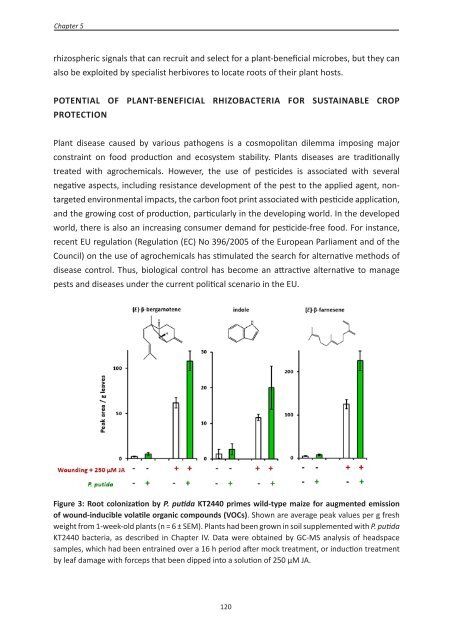Plant basal resistance - Universiteit Utrecht
Plant basal resistance - Universiteit Utrecht
Plant basal resistance - Universiteit Utrecht
Create successful ePaper yourself
Turn your PDF publications into a flip-book with our unique Google optimized e-Paper software.
Chapter 5<br />
rhizospheric signals that can recruit and select for a plant-beneficial microbes, but they can<br />
also be exploited by specialist herbivores to locate roots of their plant hosts.<br />
POTENTIAL OF PLANT-BENEFICIAL RHIZOBACTERIA FOR SUSTAINABLE CROP<br />
PROTECTION<br />
<strong>Plant</strong> disease caused by various pathogens is a cosmopolitan dilemma imposing major<br />
constraint on food production and ecosystem stability. <strong>Plant</strong>s diseases are traditionally<br />
treated with agrochemicals. However, the use of pesticides is associated with several<br />
negative aspects, including <strong>resistance</strong> development of the pest to the applied agent, non-<br />
targeted environmental impacts, the carbon foot print associated with pesticide application,<br />
and the growing cost of production, particularly in the developing world. In the developed<br />
world, there is also an increasing consumer demand for pesticide-free food. For instance,<br />
recent EU regulation (Regulation (EC) No 396/2005 of the European Parliament and of the<br />
Council) on the use of agrochemicals has stimulated the search for alternative methods of<br />
disease control. Thus, biological control has become an attractive alternative to manage<br />
pests and diseases under the current political scenario in the EU.<br />
Figure 3: Root colonization by P. putida KT2440 primes wild-type maize for augmented emission<br />
of wound-inducible volatile organic compounds (VOCs). Shown are average peak values per g fresh<br />
weight from 1-week-old plants (n = 6 ± SEM). <strong>Plant</strong>s had been grown in soil supplemented with P. putida<br />
KT2440 bacteria, as described in Chapter IV. Data were obtained by GC-MS analysis of headspace<br />
samples, which had been entrained over a 16 h period after mock treatment, or induction treatment<br />
by leaf damage with forceps that been dipped into a solution of 250 µM JA.<br />
120

















